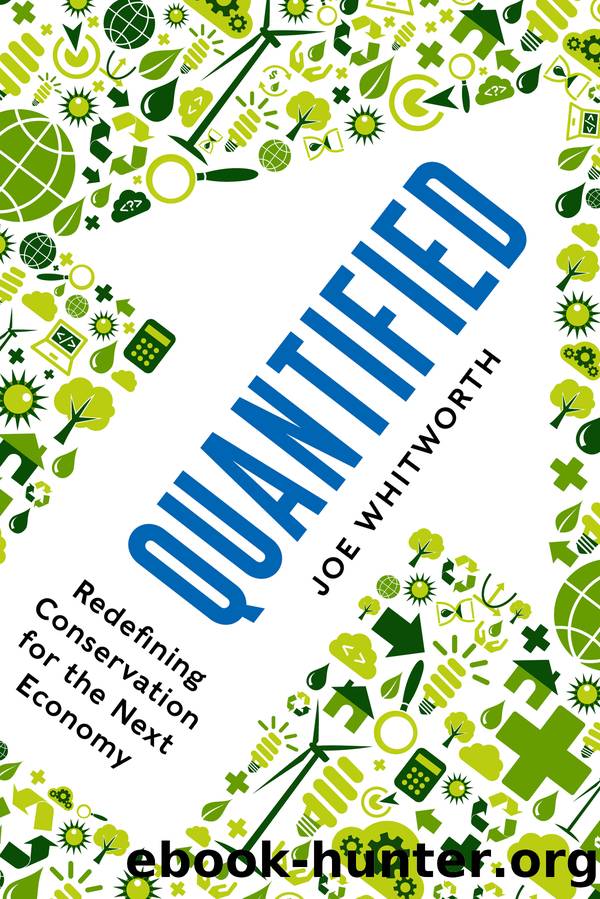Quantified: Redefining Conservation for the Next Economy by Joe Whitworth

Author:Joe Whitworth [Whitworth, Joe]
Language: eng
Format: epub
Tags: nature, Ecosystems & Habitats, Rivers, political science, General, Public Policy, Environmental Policy, science, Environmental Science
ISBN: 9781610916141
Google: xFdjCgAAQBAJ
Publisher: Island Press
Published: 2015-09-08T23:41:14.213521+00:00
CHAPTER 7
Lessons from an Aussie Water Shock
IF YOUâVE EVER BEEN to Las Vegas, youâve probably seen the elaborate hotel fountains that shoot 500 feet into the air. Youâve probably swum in a Roman-themed swimming pool or played golf on a lush course kept green by hundreds of sprinklers. Maybe youâve even ridden around in a gondola on an artificial canal modeled after the city of Venice.
Yet like a lot of things in Las Vegas, the seemingly endless supply of water is an illusion. The city, whose population has skyrocketed from 400,000 to two million residents over the last decade, relies on Lake Mead for 90 percent of its water.1 But the problem is that Lake Mead is running dry.
Created by the construction of the Hoover Dam on the Colorado River, Lake Mead was filled to the brim less than 2 decades ago. But in 2000, the nationâs largest reservoir started to drop, and today it is about 40 percent full.2 If the water level drops below 1,000 feet above sea level, Lake Mead will be too low to carry water through the two tunnels that supply Las Vegas, Los Angeles, and several states. Yet thatâs exactly whatâs happening. Today, Lake Mead stands at about 1,100 feet above sea level. If we continue to gobble up water at the current rate, the water level will sink far below 1,000 feet, with a 50 percent chance of becoming a âdead poolâ by 2036.3
Anticipating the crisis, the Southern Nevada Water Authority has been busy drilling a new $1-billion tunnel to suck up the last remaining water as the water level continues to drop. In addition, Las Vegas wants to build a $15.5-billion pipeline that would pump groundwater from an aquifer 260 miles away in rural Nevada. But environmentalists are challenging the proposal, and so far the courts have agreed with their argument that the project would harm habitat for trout, birds, deer, and elk.
In the meantime, Las Vegas has taken significant steps to cut back its water use. Itâs subsidizing the cost of water-efficient appliances. Itâs offering a rebate program to convince residents to rip out their grass lawns.4 And itâs been recycling almost all water used indoors by its 40 million annual visitors and returning it to Lake Mead.5
As admirable as these actions are, theyâve been no match for the scope of the problem, and Las Vegas continues to lose its gamble with water. âThe situation is as bad as you can imagine,â said Tim Barnett, a climate scientist at the Scripps Institution of Oceanography. âItâs just going to be screwed. And relatively quickly. Unless it can find a way to get more water from somewhere Las Vegas is out of business.â6
Las Vegas isnât the only place thatâs hurting from a diminished Colorado River (figure 7.1). For 6 million years, the 1,450-mile river flowed from the snowy Rocky Mountains in Colorado southwest through seven states, emptying 14 million acre-feet of freshwater into the Sea of Cortez in Mexico.7 Yet today, the Colorado
Download
This site does not store any files on its server. We only index and link to content provided by other sites. Please contact the content providers to delete copyright contents if any and email us, we'll remove relevant links or contents immediately.
Zero to IPO: Over $1 Trillion of Actionable Advice from the World's Most Successful Entrepreneurs by Frederic Kerrest(4295)
Machine Learning at Scale with H2O by Gregory Keys | David Whiting(4179)
Never by Ken Follett(3790)
Harry Potter and the Goblet Of Fire by J.K. Rowling(3774)
Ogilvy on Advertising by David Ogilvy(3510)
Shadow of Night by Deborah Harkness(3303)
The Man Who Died Twice by Richard Osman(2997)
Book of Life by Deborah Harkness(2867)
The Tipping Point by Malcolm Gladwell(2827)
Will by Will Smith(2793)
0041152001443424520 .pdf by Unknown(2784)
My Brilliant Friend by Elena Ferrante(2774)
How Proust Can Change Your Life by Alain De Botton(2742)
Purple Hibiscus by Chimamanda Ngozi Adichie(2652)
How to Pay Zero Taxes, 2018 by Jeff A. Schnepper(2602)
Hooked: A Dark, Contemporary Romance (Never After Series) by Emily McIntire(2500)
Rationality by Steven Pinker(2291)
Borders by unknow(2229)
Can't Hurt Me: Master Your Mind and Defy the Odds - Clean Edition by David Goggins(2227)
